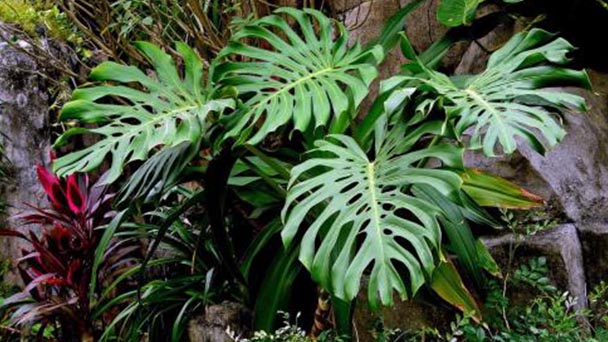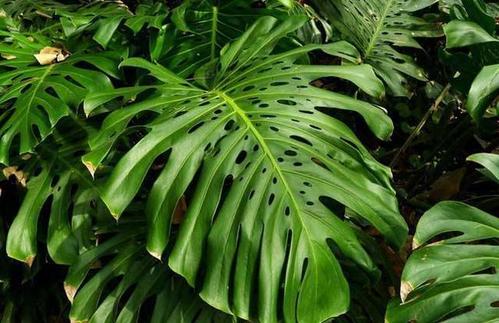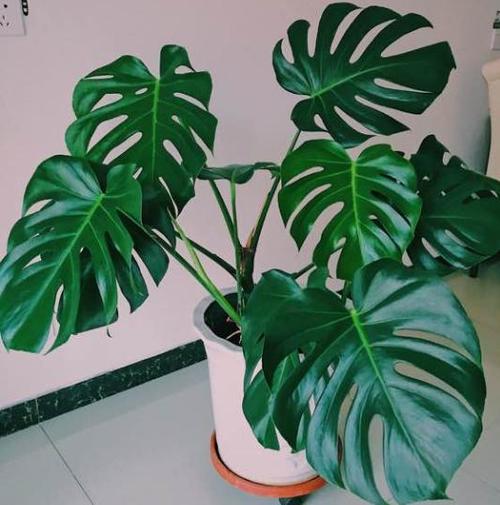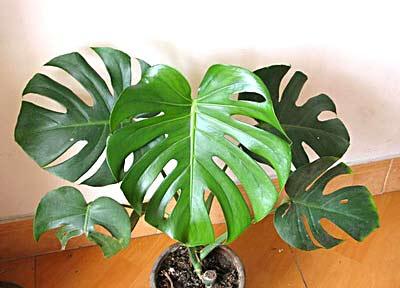Swiss cheese plant profile
Written by Maggie
Jan 11 2021

Swiss cheese plant is an evergreen liana plant with thick stems. Young plants are heart-shaped, broadly ovate, pinnate, deeply lobed, oblong-veined, long stipe, dark green. The inflorescence is a Buddha flame, Buddha flame bract navicular, flowering in November, pale yellow.
Swiss cheese plant picture

Morphological characteristics of Swiss cheese plant
Swiss cheese plant is a plant of The Genus Swiss cheese plant of the Araceae family. The leaf shape is peculiar, hole crack shape resembles the turtle back extremely. The stem node is stout and similar to Phyllostachys aurea, dark brown gas.
Roots are vertical and horizontal, shaped like wires. Its leaves are green all the year round, very resistant to shade, and is a famous indoor large pot plant.
Stems are green, stout, with pale half-moon markings, circumferential, smooth, 3-6 m long, 6 cm thick, 6-7 cm long internodes, with aerial roots. The petiole is green, often up to 1 m long, flat ventral, 4-5 cm wide, abaxially obtuse, coarse, sharp edge, base very wide, folded stem, arranged in a tile, shaped like iris, wide on both sides of leaf sheaths, upward tapering, after falling off the petiole edge into a crepe wave; The leaf blade is large, heart-shaped and ovoid in outline, 40-60 cm wide, thick leathery, shiny in surface, light green in color, green-white in back, with pinnate edges, 1-2 large voids between lateral veins, mostly transverse round, 1.5-4 cm wide near the rib, transverse elliptic, 5-6 cm wide. The surface of the middle rib and lateral veins is green, the back is green and white, both sides are uplifted; The secondary veins are 8-10 pairs, base close to each other, ascending gradually away, grade II, III, IV veins reticulate, inconspicuous.
Inflorescence of Swiss cheese plant stalks are 15-30 cm long, 1-3 cm thick, green, coarse. Bracts are thickly leathery, broadly ovate, navicular, suberect, apex beaked, 20-25 cm long, artificially flattened 15-17.5 cm wide, pale yellow. Inflorescences are sub cylindrical, 17.5-20 cm long, 4-5 cm thick, pale yellow. Stamen filaments are linear, pollen yellow-white. Swiss cheese plant pistil is gyro - shaped, 7-8 mm long, stigma small, linear, longitudinal, yellow, slightly convex. Berries are pale yellow, with cyan blotches around stigma, 1 cm long, 7.5 mm thick. Flowering: August - September. Fruit ripens after alternate flowering.
Swiss cheese plant growth habit
Swiss cheese plants like warm, wet, half shade environments, avoid direct sunlight and dry, half shade, and are more resistant to cold. The suitable temperature for growth was 20 ~ 25℃, and the temperature for overwintering was 3℃. The soil requirements were not strict, and the soil grew well in the fertile sandy loam rich in humus. Swiss cheese plants can be potted with leaf rot soil, garden soil and river sand, etc. Small basins should be changed once a year, while large basins should be changed once every 3 to 5 years. It is advisable to change basins in the middle of April every year. Pay attention to the right amount of pruning withered yellow leaves, old leaves. When potted, a layer of coarse coal cinder blocks (grains) is put at the bottom of the pot as a drainage layer, and a layer of culture soil is spread. A small amount of phosphate fertilizer, bone powder, dry cow manure, dry chicken manure and other basic fertilizer are added during planting to promote its vigorous growth.

Swiss cheese plant distribution region
Swiss cheese plants are commonly used in Europe, America and Japan for potted ornamental plants, as well as decoration in guest rooms and windowsills.
In South American countries Brazil, Argentina and Mexico in Central America, in addition to potted plants, they are often planted next to perches or buildings. Swiss cheese plants grow on perches or on walls, making them excellent vertical greening materials.
It is cultivated in open fields in Fujian, Guangdong, Guangxi and Yunnan, and in greenhouses in Beijing and Hubei. Swiss cheese plant is native to Mexico, the tropical areas of many species for ornamental cultivation.
The main value of Swiss cheese plant
Ornamental value
Swiss cheese plant has beautiful shape, peculiar leaf shape, dark green leaf color, and full of luster, the whole plant has ornamental effect.
The fruit is good. The Swiss cheese plant, which is widely introduced and cultivated in Our country, is a famous indoor potted leaf-watching plant. In addition, Swiss cheese plants have the effect of absorbing carbon dioxide at night, which is of great help to improve indoor air quality and increase oxygen content. As an ideal indoor plant, it has the characteristics of preferential absorption of harmful gases such as formaldehyde, benzene and TVOC to purify indoor air.
Edible value
The fruit is tasty and edible, but often has a numbing taste.
When ripe, the fruit can be used for cooking. It is sweet and tastes like pineapple or banana. But paying attention to the fruit is not ripe and can not be eaten, because there is a strong irritation. Residents in the country of origin call the fruit "the fairies' gift".

Latest Updated
- Benefits of Bugleweed - 7 Science-backed Health Benefits
- Bugleweed Dangers & Side Effects - Is It Poisonous?
- How to Plant Evergreen Trees - What You Should Know
- When to Plant Evergreens - Grow Guide for Evergreen Trees
- 12 Wonderful Evergreen Shrubs for Your Garden
- 12 Popular Evergreen Plants with Pictures for Beginners
- When And How To Prune A Lilac Bush Like a Pro
- How to Grow & Care for Lilac Vine (Hardenbergia Violacea)
- Japanese Lilac Tree (Syringa Reticulata) Care & Propagation Guide
- Shumard Oak Pros and Cons - What to Know
Popular Articles
- Winter maintenance of Antirrhinum Majus
- How to Grow Terminalia Mantaly Tree
- How to Grow and Care for Crossostephium Chinense
- How to grow Antirrhinum Majus in spring
- Peristeria Elata (Dove Orchid) Profile: Info & Care Guide
- Underwatered Snake Plant (Sansevieria Trifasciata) - Signs And How To Fix
- How to Care for Brazilian Jasmine Plant (Mandevilla Sanderi)
- How to Grow & Care for Graptopetalum Purple Delight in Summer
- Rosa Chinensis (China Rose): Plant Growing & Care Tips
- How to Care for Baby Sun Rose (Aptenia Cordifolia)